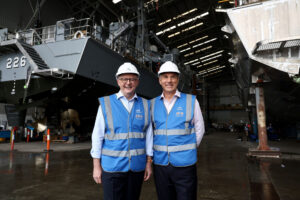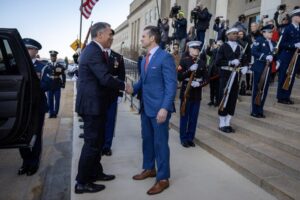Australia does not need an increase in spending on the military
Right now, the government and the opposition are moving to increase the amount the government spends on its military aka its defence budget, and this is happening without the public having any say – nor any great choice in the upcoming election.
The Trump administration, including Elbridge Colby, who is soon to be confirmed as head of policy at the US Defence Department, is now telling Australia it needs to spend 3% of GDP on the military. That would be quite a large increase from what Australia currently spends, but rather than push back, both major political parties are fully in step with the view that Australia needs to spend more boosting our military.
The Treasurer, Jim Chalmers told reporters, “We’re taking defence spending from about 2 per cent of our economy to more than 2.3 per cent in the course of the next decade or so.” The Coalition also seems to be considering an advance on this position and lifting the military budget to 2.5 per cent of GDP by 2029.
The budget papers explain just how much is being spent on both the ongoing military spending, as well as the capital investment.
For the capital investment, the budget papers give both “net capital investment” as well as “purchases of non-financial assets”. The main difference is that the former is adjusted for depreciation and amortisation, while purchases of non-financial assets are not adjusted. There really is no good reason for deducting depreciation and amortisation. They are both rather meaningless concepts when it comes to military assets – is anyone really caring about the decline in the commercial value of the tanks the army has? Moreover, almost all discussions of the budget balance etc are based on cash accounting, which excludes depreciation.
The table above presents the military expenditure and investment.
It clearly shows that total military spending has hit 2.3% of GDP (rounded) in 2024-25, and yet in his Budget speech, the Treasurer said “defence funding will grow beyond 2.3 per cent of GDP by the early 2030s.”
That suggests the Government is using the depreciation adjustment to estimate its spending. In reality, the Treasurer should already be saying that Australia is already at 2.3% of GDP and headed for 2.5%.
Importantly, however, this has all happened with very little debate.
Just a decade ago the 2015 Intergenerational Report mentioned that defence had been 1.6% of GDP in 2012-13 and was expected to be 1.8% of GDP in 2014-15 and, “consistent with government policy, [military spending] is projected to increase gradually to 2 per cent of GDP by 2023-24… [and constant] at 2 per cent of GDP from 2023-24 onwards …”
That goal of reaching 2% has been superseded, and now the discussion seems to be around 2.5 to 3% – all of which has occurred without any real debate with or approval from voters.
We should be clear about what going from 1.6% of GDP to 2.5 to 3% of GDP means. It has already meant that other options for spending around $20 billion in 2025-26 have been ruled out. No increase in Jobseeker, less spending on public schools, and hospitals and vital infrastructure needed to shift Asutralia to a low emissions economy.
Other options will be ruled out in the future.
Even in its own terms, the target of spending 2.5% or even 3% on the military is nonsensical. Obviously, the military bureaucracy will find a way to spend any amount of money. But that is a far cry from asking them to make plans that reflect careful risk management, reflecting clear priorities and taking into account the true opportunity costs of the foregone alternatives.
This election deserves a true debate about how much should be spent on the military.
Related research
Between the Lines Newsletter
The biggest stories and the best analysis from the team at the Australia Institute, delivered to your inbox every fortnight.
You might also like
You know what’s more idiotic than a photo op? Walking blindly into the AUKUS pact
There was a lot of hysteria over the symbolism of former premier Daniel Andrews’ photo op with assorted dictators at a Chinese WWII military ceremony, but precious little discussion or analysis of the so-called threats to Australia’s security.
Australia must resist US bullying to increase military spending
The US secretary of defense, Pete Hegseth, may not be the sharpest tool in President Trump’s tool kit. But, in the great American tradition, he is a top hustler. In an arrogant display that would have won Trump’s approval, Hegseth blustered his way around the Shangri-La conference in Singapore’s clammy weather last week in what resembled an ugly American charm offensive. He omitted tariffs, though these were front of mind for everyone else.
Australia already spends a huge amount on defence
The debate on defence ignores that Australia already spends more than it should.


